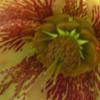
Galanthus plicatus ‘Sarah Dumont’
In response to those readers who, like me until recently, can’t see the obsession and fascination with snowdrops – after all aren’t they all the same I would point to the photograph above. This is of Galanthus plicatus ‘Sarah Dumont’ and I think is quite distinct from the everyday Galanthus nivalis
Anyone who reads this blog regularly will know that over the last month I have been exploring the world of galanthophiles in a bid to try to understand the fascination. This isn’t the first time I have put my toe in the water so to speak, back in 2011 I visited John Sales garden to see his collection of snowdrops but I found myself still struggling. I have also looked at various magazine articles etc and it isn’t easy.
Anyway, on Sunday, my eyes were finally opened and it started to make sense. I attended the Galanthus Group study day in Leominster. As soon as I arrived I went to look at the plant sale tables and here it quickly became apparent what a variety there is. I believe that if you are a newbie to galanthus you really need to see a collection of them set beside each other so you start to notice the different heights, size of flowers, foliage, markings etc. I find myself particularly drawn to the snowdrops with long outer petals.
The first talk of the morning, ‘Snowdrops in the Green’, focussed on the green markings of snowdrops – or virescence. The speaker, Jim Almond, went through the different groups of snowdrops (nivalis, elwesii, plicatus, woronowii and ikariae) and showed us ones which were particularly well-marked. He also touched on caring for your snowdrops stressing the importance of dividing them every 3 years or so to maintain the clump’s vigour; passing some to friends so if you lose yours there might be a ready supply elsewhere; growing some in pots as a back-up; and feeding every Autumn with bonemeal. He identified some that were good doers and would bulk up quickly: Galanthus plicatus ‘Trymlet’ and Galanthus ‘Modern Art’. These are now on my wish-list. Any would be galanthophile has to have a wish-list apparently – mine is quite humble.
The second talk of the morning was by Joe Sharman, a very respected galanthophile and breeder. He talked about rare, curious and new snowdrops. I have to admit to struggling to concentrate at this point as lunch was beckoning and I think I was reaching information saturation overload by this point. Interestingly though it become increasingly clear from both talks that snowdrops can be rather troublesome and pernickety about where they want to grow. There was a lot of talk about varieties disappearing, going out of circulation, being hard to establish and multiply and I suppose this adds to the rarity, desirability and cost of some of them. There was also much criticism of the prices being paid on ebay and charged by one well-known retailer when the same plants can be bought from specialist nurseries for much less.
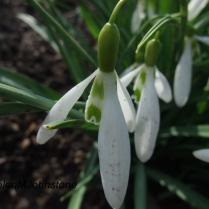
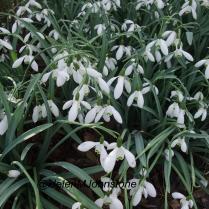
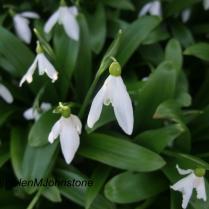

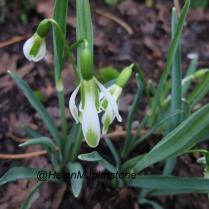
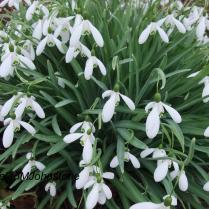
Note: I am 90% certain I have the right names against each snowdrop
Lunch over and we made our way to Ivy Croft to see the snowdrops growing. I nearly missed this part of the day due to other commitments but one of the ladies I met persuaded me that I really needed to see clumps of the different varieties to appreciate them better and she was right. Luckily I had met up with some friends from another garden group I attend and they were far more knowledgeable than me and could identify many of the different varieties. Whilst I still love the vast sweeps of snowdrops as shown in previous posts, and many at the study day did too, I found it fascination to see all the variations. I found myself drawn to the taller and beefier snowdrops rather than the tiny and short ones, though there was speculation this was due to my eye sight getting worse! It appears that due to the vastness of varieties available people often collect specific groups – one lady was collecting all the ones named after insects, such as Wasp (which is a lovely snowdrop and on my list).
So to conclude the ‘white fever’ hasn’t grabbed me as it has one lady I spoke to who admitted to having “around 200 varieties” but I have decided to start collecting snowdrops with the plan to add a few each year. If I am honest it isn’t just the differences in the varieties but also the people who drew me in as they were a friendly and interesting group. But above all, I think that part of the attraction must be the beauty of snowdrops at a time of year when there is very little else in flower.
I would like to thank my blogging friend Anna for her encouragement and advice in recent weeks – she is a real snowdrop addict.
